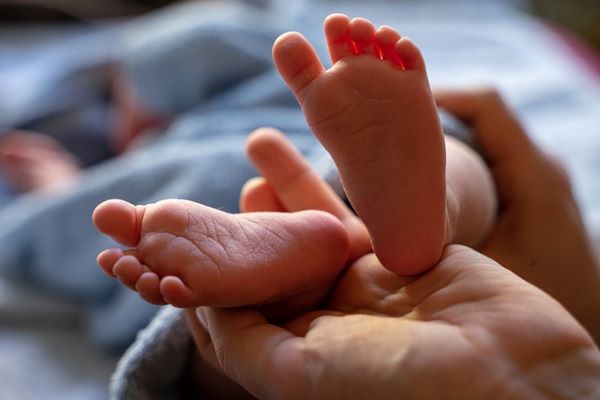Clubfoot (also known as talipes equinovarus) is a congenital birth defect in which a baby’s foot is twisted out of shape or position. In this condition, the tendons connecting the leg muscles to the foot are shorter than usual, causing the foot to turn inward and downward. Clubfoot is a relatively common condition, affecting around 1 in 1,000 live births globally, with boys being more frequently affected than girls. Early intervention, such as casting and corrective surgery, can successfully treat this deformity, allowing children to lead normal, active lives. (Source)
Also, read: Now Know All about Spina Bifida: Cause, Symptoms, Diagnosis, Treatment
What is Clubfoot?
It refers to a condition where a newborn’s foot or both feet are abnormally twisted at the ankle. The foot may turn inward, downward, or even sideways. The deformity affects the bones, muscles, tendons, and blood vessels in the foot and lower leg, making it difficult or impossible for the child to walk properly if left untreated.
There are two primary types of clubfoot:
- Isolated (Idiopathic) Clubfoot: The most common form, which occurs as a separate condition, not associated with other congenital abnormalities.
- Non-Isolated Clubfoot: This form is often associated with other conditions such as spina bifida or arthrogryposis (a condition affecting joint movement). (Source)
How is Clubfoot Caused?
The exact cause of clubfoot remains largely unknown, but it is believed to be influenced by a combination of genetic and environmental factors. There is often no clear explanation for why a child develops clubfoot, although family history can increase the risk. Some theories suggest that abnormal positioning in the womb may contribute to the deformity, but this theory has not been conclusively proven.
Genetic predisposition plays a significant role, as the likelihood of it increases if parents or siblings have had the condition. Environmental factors, such as smoking during pregnancy, can also increase the risk. (Source)
History and Science of Clubfoot
It has been recognized for centuries, with historical references dating back to ancient Egypt. The earliest recorded treatment for clubfoot appears in Egyptian artifacts, and the deformity was described in detail by the Greek physician Hippocrates around 400 BC. Hippocrates advocated for early intervention with gentle manipulation and splinting, a concept that remains central to modern treatment.
The most significant development in the treatment of it came in the 20th century when Dr. Ignacio Ponseti, a Spanish physician, developed the Ponseti method in the 1940s. This non-surgical technique uses a series of casts to gradually correct the foot’s position, revolutionizing the way clubfoot is treated worldwide. Before the widespread adoption of this method, invasive surgeries were often used to treat the condition, with varying success rates. (Source)
Risk Factors for Clubfoot
While the exact cause of it remains unclear, several risk factors may increase the likelihood of a baby being born with the condition:
- Genetics: A family history of it increases the risk. If one parent has had clubfoot, there is a higher chance their child will have it as well.
- Sex: It is more common in males than females, with boys being affected approximately twice as often.
- Smoking during pregnancy: Pregnant women who smoke are more likely to have babies with it, possibly due to the effect of smoking on fetal development.
- Oligohydramnios: This condition involves low levels of amniotic fluid during pregnancy, which may contribute to abnormal positioning in the womb and increase the risk of clubfoot.
- Infections during pregnancy: Certain infections or complications during pregnancy may contribute to the development of birth defects like clubfoot. (Source)
Treatment for Clubfoot
It is treatable, especially if detected early. The treatment aims to correct the position of the foot, ensuring the child can walk normally without pain or limitations.
- The Ponseti Method: The most common treatment for clubfoot today is the Ponseti method, which involves:
- Manipulation and Casting: A series of casts is applied, typically starting soon after birth, to gradually reposition the foot. Each cast is replaced weekly until the foot is correctly aligned, usually after 6 to 8 weeks.
- Achilles Tenotomy: In some cases, a minor surgical procedure called a tenotomy may be necessary to release the Achilles tendon. This allows the foot to move into the correct position.
- Bracing: After the casting, a brace is worn to maintain the corrected position and prevent relapse. The brace is typically worn full-time for a few months and then only at night for several years.
- Surgery: If non-surgical methods like the Ponseti method are unsuccessful, surgery may be necessary to correct the position of the foot. Surgical treatment involves lengthening tendons and repositioning bones, but it is generally considered a last resort due to the risks of stiffness and other complications.
- Physical Therapy: In some cases, physical therapy may be recommended to strengthen the muscles and improve mobility following treatment. (Source)
Can Clubfoot Be Prevented?
There is no surefire way to prevent clubfoot, as the exact cause is not fully understood. However, certain steps can be taken to minimize the risk:
- Folic Acid: Ensuring an adequate intake of folic acid before and during pregnancy can help reduce the risk of various birth defects, though there is no specific evidence linking folic acid to the prevention of clubfoot.
- Avoid Smoking: Pregnant women should avoid smoking and exposure to secondhand smoke, as it has been linked to an increased risk of clubfoot.
- Healthy Pregnancy: Maintaining a healthy lifestyle and ensuring proper prenatal care may help reduce the risk of birth defects, including clubfoot. (Source)
Is Clubfoot Hereditary?
Yes, genetics play a role in clubfoot, and it is more likely to occur if there is a family history of the condition. However, even when clubfoot runs in families, the exact way it is inherited is complex and not fully understood. Genetic counseling may help families understand their risk of having a child with clubfoot.
Can Clubfoot Be Cured?
Clubfoot can be successfully treated, especially when therapy begins shortly after birth. The Ponseti method, in particular, has proven highly effective in curing clubfoot. Most children who undergo treatment early can walk and run normally, with few, if any, long-term complications. However, the condition requires long-term monitoring to ensure that the foot does not revert to its twisted position as the child grows.
While severe cases may require surgical intervention, the outlook for children with clubfoot is generally positive with appropriate treatment. Early diagnosis and consistent follow-up care are key to ensuring the best possible outcome.
Also, watch web stories: How do l keep my children from getting autism
Conclusion
Clubfoot is a congenital condition where a baby’s foot is abnormally twisted at birth. Though the cause is not entirely understood, genetic and environmental factors, such as family history and maternal smoking, are known to increase the risk. Treatments like the Ponseti method have revolutionized care for clubfoot, allowing most children to lead normal, active lives after therapy. Early diagnosis, careful treatment, and long-term follow-up care are essential in managing the condition.





